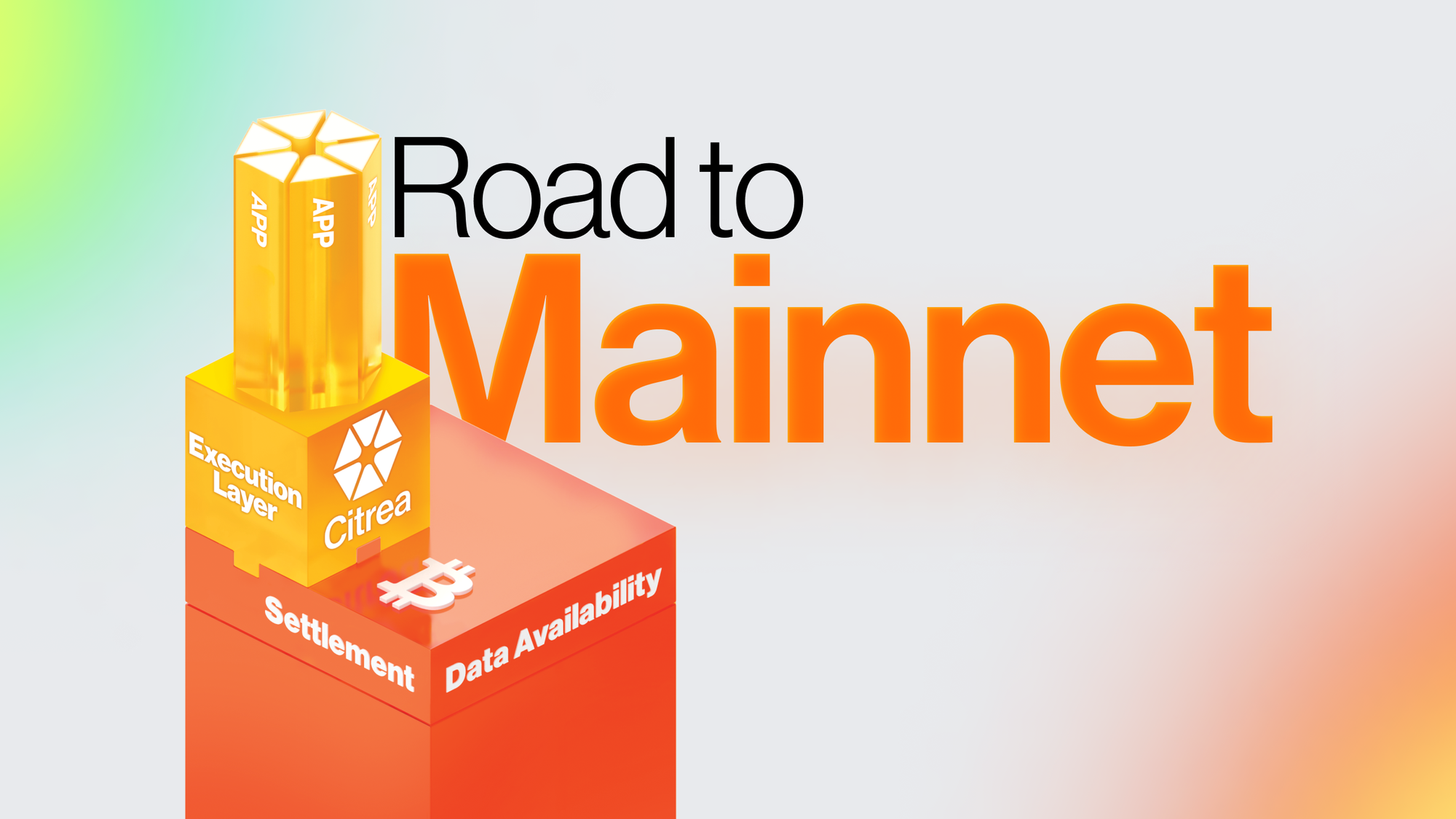Road to Mainnet by Orkun Kilic

When we started building Citrea over a year ago, our roadmap was taking shape, but our goal was always clear: break Bitcoin free from custodians and trust. Over the last 1.5 years, we have conducted extensive research and engineering to construct the foundation of Citrea. We’ve released the first public devnet and testnet of a ZK rollup on Bitcoin, along with numerous non-technical contributions to the ecosystem, such as educational content and events.
Now, it’s time to sit back and assess what we’ve built so far and what lies ahead! While I won’t provide exact dates, I’ll discuss the tasks we’re working on and their scope.

The Past
Citrea Codebase
As of this writing, the Citrea codebase has 1,392 squashed commits—not counting the countless issues, tests, and deployments we’ve completed. The Citrea codebase is the backbone of our rollup, encompassing full node logic that’s shared by both the sequencer and prover, built into this repository. We built our own STF from scratch, including consensus-critical checks like Bitcoin DA and soft block limits, along with the EVM runtime (extending revm). The state-of-the-art implementation utilizes two zkVMs: Risc0’s zkVM 1.0 and Succinct’s SP1.
Clementine and BitVM Codebase
Clementine, Citrea’s BitVM-based two-way peg program, now boasts 758 commits! Clementine includes operator and verifier binaries, gRPC communication, Bitcoin transaction signing logic, DB operations, and the BitVM interface. It’s deployed on our testnet, orchestrating deposits and withdrawals using kick-off and pre-signed transactions. The work-in-progress component is fraud proofs, which will be enabled with BitVM.
BitVM
BitVM deserves a special mention as it’s the best technique available today for building trust-minimized Bitcoin bridges. It’s becoming the foundation for many bridges, but what makes BitVM + Citrea (Clementine) powerful is the trustless Citrea Light Client. BitVM requires a Bitcoin Light Client (LC) to operate and account for operators’ withdrawals. Since Citrea already uses Bitcoin as a data availability layer, a single Bitcoin LC is sufficient to manage all the logic without requiring attestations from other chains (e.g., sidechains or optimiums).
ICYMI, we’ve joined the “BitVM Alliance” as a founding member. Alongside other contributors, we’re building the BitVM2 implementation, targeting completion by January 1, 2025! This is one of the most significant milestones for Bitcoin to date, and we’re thrilled to be part of history.
Ecosystem
We’re not just building a technology; we’re building an ecosystem of developers, which we hope will become a major contributor to both Citrea and the broader Bitcoin ecosystem. Since launching our devnet, we’ve integrated numerous infrastructure partners. These partners not only make building on Citrea easier, but also enable the next generation of Bitcoin applications, together with the developers building on Citrea.
Despite its recent launch, our testnet has already attracted developers from different blockchain ecosystems. We’ve integrated with existing infrastructure like Hyperlane, connecting Citrea to other blockchains. Additionally, builders have expressed interest in creating new Bitcoin applications, with a few already in beta and more on the way (stay tuned 👀).
We continue to release educational content both online and in-person. Our blog and docs are packed with interesting material—highly recommended! We also regularly host our flagship event series, “Scaling Bitcoin Together.” So far, we’ve held four of them in Istanbul, Hong Kong, Brussels, and Bangkok.
Road to Mainnet
Citrea Codebase
The Citrea task list, managed by contributors, is being tracked as we march toward mainnet. Contributors are working on integrating both zkVMs as part of our multi-prover strategy, with various optimizations in progress. Regarding proving, we’ve just completed the implementation of Light Client Proofs (aggregated batch proofs), which will serve as the foundation for Clementine.
Beyond multi-prover and Light Client Proofs, the road to mainnet includes enhancements like:
- Faster proof generation through cycle count optimization
- Reduced DA consumption via stateful compression
- New EVM precompiles for additional features such as EIP-7212
- Node pruning for smaller, more efficient nodes
These developments will bring the Citrea codebase closer to production-ready stability, paving the way for additional features like native account abstraction!
Clementine and BitVM
For Clementine, the main challenges are BitVM2 assert/disprove transactions and Light Client Proofs. Contributors are tracking tasks related to these two key components. Meanwhile, we’re also working on various improvements, such as enhancing our DB structure and reducing communication overhead between nodes. These tasks are expected to be completed in parallel with the Citrea codebase.
Another exciting update on this front: our team is working on a new Bitcoin Light Client construction, which will be used in BitVM to enable cheap and secure Bitcoin verification. Expect a detailed write-up on this very soon!
Together with the BitVM Alliance, we expect to align our timelines, ensuring that no single task delays our mainnet launch!
Ecosystem
To me, this is the most important component of Citrea. We’re scaling Bitcoin’s functionality and user experience. Developers and our ecosystem are key enablers. We’re building the infrastructure and helping developers and teams realize a Bitcoin-backed economy. We envision a world where Bitcoin is held in smarter, self-custodial wallets that provide trustless access to services that currently require custodians.
That’s why we’ve launched Citrea Origins, a unique incubation program to accelerate the Bitcoin-backed economy. We’re helping developers refine their product roadmaps, engage in hardcore engineering, build and grow on-chain and off-chain communities, and fundraise. Our experienced team is deeply involved in ecosystem projects, including myself.
The first batch of participants, along with fresh applicants, gathered in Bangkok from November 3-10. Our entire team was on-site, working side-by-side with the builders of Bitcoin’s future.
If you share our vision for Bitcoin, apply to Origins. We’re excited to collaborate with smart developers and growth hackers!

Citrea Origins extends beyond mainnet, but it remains my primary focus until then. Hyperbitcoinization is the endgame.
The Future
We laid out Citrea’s post-mainnet specifications months ago, and they’ve largely remained the same from a technical standpoint. However, we’ve started to write specs for most of them. Contributors are working hard on multi-proving, which will be followed by decentralized sequencing and the volition model.
For Clementine, we’re already experimenting with BitVM optimizations and reviewing proposed soft forks to assess their impact on BitVM and a potential ZK verifier script.
We’re excited to support the mainnet launch of Origins projects and look forward to welcoming new applications after the mainnet launch.
The future of Bitcoin is being built by today’s visionaries.
Orkun Mahir Kilic
Co-Creator of Citrea
Co-Founder and CEO of Chainway Labs

